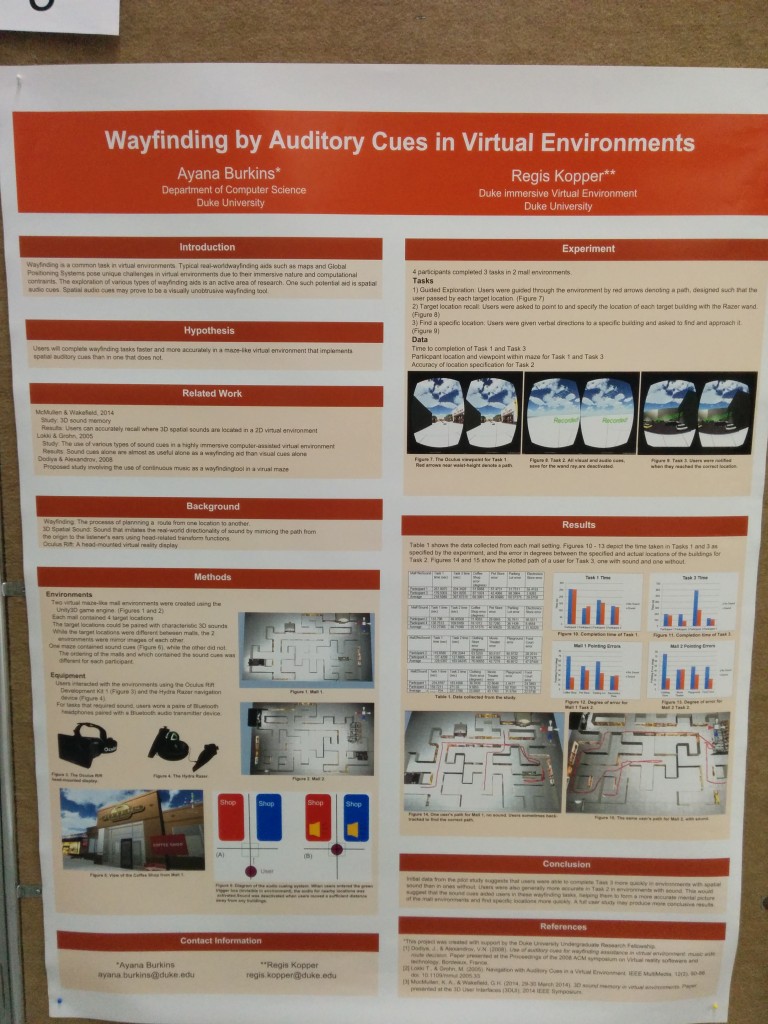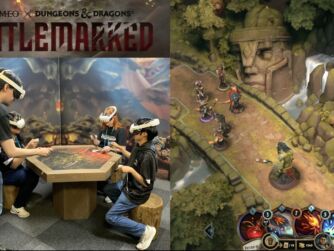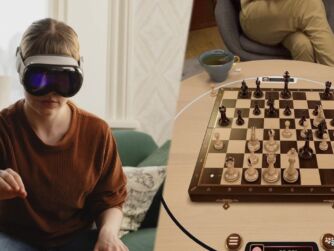 Ayana Burkins is a student at the Duke immersive Virtual Environment program at Duke University. She was at IEEE VR presenting a poster on “Wayfinding by Auditory Cues in Virtual Environments.”
Ayana Burkins is a student at the Duke immersive Virtual Environment program at Duke University. She was at IEEE VR presenting a poster on “Wayfinding by Auditory Cues in Virtual Environments.”
Become a Patron! Support The Voices of VR Podcast Patreon
Theme music: “Fatality” by Tigoolio
Subscribe to the Voices of VR podcast.
Rough Transcript
[00:00:05.452] Kent Bye: The Voices of VR Podcast.
[00:00:12.098] Ayana Burkins: I'm Ayana Birkins. I'm an undergraduate junior at Duke University working with Professor Hedges Copper on a project involving the use of sound as a wayfinding device in virtual environments.
[00:00:24.110] Kent Bye: OK, great. So tell me a bit about what type of things you set up and what type of questions you were asking and what you found.
[00:00:31.122] Ayana Burkins: Well, the question I was asking is, I wanted to find a way to provide a wayfinding tool that doesn't include objects in the environment, that's less obtrusive than things like maps or GPS that are common in the real world. wayfinding tasks. So the idea of the sound cues is that that they are non-visual and specifically spatial sound which is like it has like the sense of direction you get from you know being closer like depending on like your orientation in relation to the source of the sound. And the idea is that these sound cues will help people perform wayfinding tasks in virtual environments more quickly and more accurately than in environments without these sound cues. So the experiment I ran was, we have these two Bayes environments. They're actually mirror images of each other, but initial poly data suggests that people don't realize that. And that was just to keep any kind of inconsistencies in the design of the maze out of the equation. So each one is kind of modeled after a mall in the sense that you have different target locations. For example, there's a pet store, there's a coffee shop, a food court, and they each have specific sounds associated with them that are characteristics. So the pet store has a dog barking, for example. So each user would perform tasks in both malls. One would be with sound and one without. And that ordering and which mall had the sound would switch between participants. And they would perform three different tasks here. So they would, you know, go through the environment and try to learn where all the buildings are and hear all the sounds. And then they would be asked to point to where they perceived all of the different target locations as being. with no visual cues other than just the skybox and the ground. And then they would be asked, finally, to find a specific location from the beginning of the maze and approach it. And we found that, just based on the initial pilot data, that people tended to spend less time in the environments with sound, suggesting that they were able to find their target more quickly. and that their accuracy in pointing to the buildings was more accurate. So that's good news. I think that hopefully suggests that the sound cues help people perform the wayfinding task more quickly and accurately. And we're also working on a full study with 16 participants that will hopefully provide more conclusive results.
[00:02:59.185] Kent Bye: And so when they're doing the final decision of where things are at, you're sort of taking away all the walls. You just have the ground and the skybox. And so it sounds like people are creating a mental map of the space and having the auditory cues helps accentuate or make those mental maps more vivid is what it sounds like.
[00:03:15.032] Ayana Burkins: Right. Yeah. The idea of the second task is to test how well they're able to form that cognitive map.
[00:03:22.135] Kent Bye: Interesting. And so what type of audio specialization tools did you use in order to actually specialize the audio?
[00:03:28.008] Ayana Burkins: So this is actually really simplified. There's no filtering. It's just through Unity 3D. There's an implementation for a 3D sound. And they're wearing a pair of Bluetooth headphones. And based on where they're standing, the sound will... It's mostly just panning between left and right and volume, depending on how close they are to the object. So I guess it's pretty basic in that sense. But it just helps people have a sense of where they are in relation to the object.
[00:03:57.188] Kent Bye: How did this idea to do this come about?
[00:03:59.950] Ayana Burkins: Well, I guess I started doing research on wayfinding and seeing different tools for wayfinding other than the basic ones. And there's not a whole lot in virtual reality research involving sound specifically. So I just saw it as kind of an area that wasn't being explored as much. So I thought that would be a good opportunity to contribute something new.
[00:04:24.685] Kent Bye: Great. And yeah, and finally, maybe you can mention some of the other like references or other things that people want to learn more information or our background or some of the source material that you use to support the trajectory of some of this research.
[00:04:36.134] Ayana Burkins: I'd say one of the mains would be Dr. Kyla McMullen. She did a study last year on 3D sound memory and hers was not specifically, I guess like 3D virtual environment, but she did find conclusively that people are able to remember where sounds are located, you know, over time. Also, Loki and Gron, and there's this more study of different types of sound cues. They found that that they were almost as useful as sound cues alone as visual cues. And combined, they're even better. So that kind of influenced like the idea to have both like the landmarks and the sound cues together. So yeah, those two are the main ones that I would say if you're looking for more further research in that area.
[00:05:25.797] Kent Bye: Okay, great. Well, thank you.
[00:05:28.218] Ayana Burkins: Thank you.
[00:05:29.533] Kent Bye: And thank you for listening! If you'd like to support the Voices of VR podcast, then please consider becoming a patron at patreon.com slash voicesofvr.





